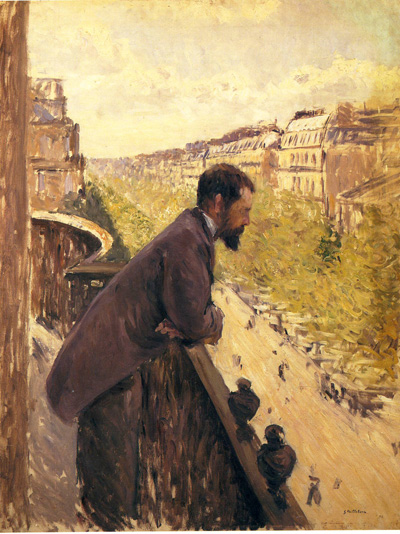Eugen Weber, France: Fin de Siècle
Changes in the Art Market
Other painters, more highly regarded today, did not do as well. The Impressionists were not of course a fin de siècle school, but the fin de siècle found them still on the
Caillebotte 1880 The Balcony |
fringes of the art market.30 After Manet's death in 1883, his Olympia had been withdrawn from his atelier sale because it failed to reach even 10,000 francs. In 1890 a private subscription led by Monet and the American painter John Singer Sargent raised 20,000 francs to buy and present it to the Museum of Contemporary Art at the Luxembourg. There it remained, half-hidden, until Monet's friend Clemenceau, prime minister in 1907, used his influence to have it transferred to the Louvre. He had to exert further influence in 1917, to get it displayed.
In 1894 a member of the Impressionist circle, Gustave Caillebotte, died and left sixty-seven paintings to the state. Renoir, his executor, had to negotiate for three years in order to obtain partial acceptance of the bequest. Twenty-five paintings, including eleven Pissaros and eight Monets, were refused and went to enrich German and American collections. Gérome, one of the favorite painters of the time, threatened to resign his chair at the Beaux-Arts: "filth . . . moral disgrace"; and the Academy officially protested the acceptance of such "a collection of horrors" into the Luxembourg Museum.31 But when, in 1908, Baron Isaac deCamondo presented the Louvre with his collection of 450 Japanese prints and 135 works by contemporaries who had been influenced by Japanese art (among them Manet, Degas, Sisley, Monet, and Toulouse-Lautrec), innocent eyes were shielded from their sight. Sylvain Bonmariage, then private secretary of the Minister of Labor, had to obtain a special order to visit them in the room where they were kept under lock and key.32
The Impressionists, as all decent people knew, were hardly respectable and not to be hung in upright homes where there were marriageable daughters. Nor were their luminous canvases portentous enough to please tormented aesthetes. The Impressionists' successors seemed still worse. In the Figaro, the pointillism of Seurat and Signac was derided as a technical jest, Gauguin's paintings as colonial art, Toulouse-Lautrec's as pictorial gangsterism, Cézanne's as a memorable joke, and, finally, in 1905, the Fauvists as art boche.33When, in 1891, Octave Mirbeau, who liked and defended Gauguin and Van Gogh, bought two of the latter's canvases (the Irises and the Sunflowers) for 250 francs each, he asked the dealer to deliver them with a note explaining that they came as a gift, lest his wife scold him for wasting his money.34
Yet the Impressionists were not as persistently ignored as it might seem. Camondo had bought them from an early date, as had enlightened businessmen like Ernest Hoschedé and Emile Rouart. Ernest Cognaq and Louise Jay, of the Samaritaine, began their great collection in the 1870s with Impressionist paintings, though they later sold most of these to concentrate on the eighteenth century. On the other hand, the director of another department store, Bader of the Galeries Lafayette, shifted his interest from the Barbizon school to the Impressionists. By 1900 Camondo was paying 43,000 francs to acquire Alfred Sisley's Flood at Port-Marly; and La Nouvelle Mode, a fashionable review, was ready to recognize the "melancholy and imbalance" of the modern style as truly contemporary: "Symbol of a tormented, refined, skeptical epoch, thirsting for an uncertain ideal, documented byincomplete science, elaborating exasperated and indecisive dreams."35 By 1910 a series of great sales would put the stamp of commercial success, not just on Impressionists (with a Degas reaching the sort of price that only the greatest academic masters had fetched in the 1880s), but on Picassos, Van Goghs, Vuillards, Bonnards, and Derains.36
The general public still appreciated the painters of the Academy, the boulevards, and the Salon. But eclecticism triumphant permitted, or rather demanded, new brushstrokes and new tastes. Paul Valéry (who courted Mallarmé's daughter) drew the conclusions of this. A surfeit of innovations can leave the senses drooping, the imagination jaded. The essence of modern art no longer lay in a particular style, but in change itself, the quest for the unexpected novelty that startles and astounds. "A good study of modern art should point out the solutions found every five years to the problem of how to shock."37
